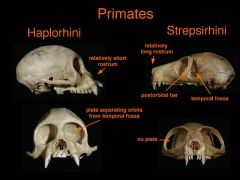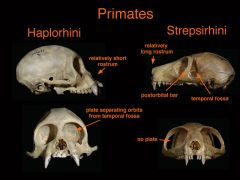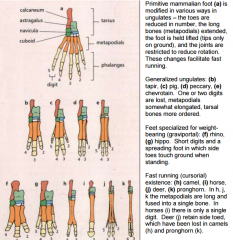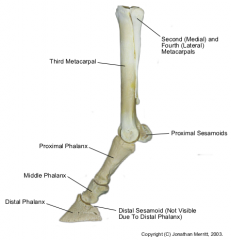![]()
![]()
![]()
Use LEFT and RIGHT arrow keys to navigate between flashcards;
Use UP and DOWN arrow keys to flip the card;
H to show hint;
A reads text to speech;
29 Cards in this Set
- Front
- Back
|
Why not use Xenarthra (endentata)? |
sloths and armadillos have cheek teeth, anteaters are toothless, pangolins were thought to be but are not closely related to edentates.
considered polyphyletic therefore not used/accepted |
|
|
O; Lipotyphla (insectivora) |
moles, shrews, tenrecs, golden moles and hedgehogs - cusped teeth for cutting worms and insects - suggested non-monophyletic considered polyphyletic therefore not used/accepted |
|
|
Chiroptera (bats) |
- true flying mammals - reduced ulna, short first digit w/ claw - remaining digits elongate and bear patagium (wing membrane) - clavicle and scapula strong - sternum with keel - baculum present |
|
|
Two orders of chiroptera and distinctions? |
Flying foxes and insectivorous bats - FF second digit of manus is relatively independant and bears a claw - IB: second digit of the manus is relatively incorporated into the wing and lacks a claw |
|
|
Primate adaptations for arboreal living |
- sturdle clavicle - forward orientation of orbits - no more than 2 incisors nor 3 premolars on one side of either jaw |
|
|
O. Primates: SO. Strepsirrhini (lemurs, bushbabies and lorises) distinction |

- orbit is in open communication with temporal fossa |
|
|
O. Primates: SO. Haplorrhini (taisers, monkeys and apes) |

- orbits completely cut off from temporal fossae by flanges from frontals, jugals and alisphenoids |
|
|
O. Primates: SO. Haplorrhini parorders |
Tarsii - Tasiers
Platyrrhini - New world monkeys (spider monkeys, howler monkets, marmosets) Catarrhini - Old world monkeys (rhesus, baboons, guenon |
|
|
Catarrhini skull and dentition characteristics |
I 2/2 C 1/1 P 2/2 M 3/3 - last molar not reduced - deflated bulla - ectotympanic extended into a long, ossified, external auditory meatus - tail never prehensile (grasping) - nostrils close together |
|
|
O. Lagomorpha (rabbits, hares and pika) dentition |
I 2/1 C 0/0 P 3/2 M 2-3/3 - herbivorous dentition - longitudinal groove - second upper incisor is small and directly behind first - fenestrated maxilla - short bony palate |
|
|
Differences between rabbits and rodents |
- R: fenestrated maxilla - R: lower jaw + upper jaw closer distance - R: prominent + angular squamosal + jugal - R: larger mandible for muscle attachment - R: Groove on teeth |
|
|
O. Rodentia dental characteristics and formula |
- single pair of incisors in each jaw which grow persistently are covered with enamel on anterior surface only and are great for gnawing
I 1/1 C 0/0 P 2/1 M 3/3 |
|
|
Only family of rodents, two main groups (what are they and how is it distinguished) |
Muridae Hystericognathy and sciurognathy - arrangement of jaw muscles H: porcupines, guinea pigs, capybaras, african mole rats S: squirrels, mice, rats, beavers, chipmunks |
|
|
How do rodent incisors stay sharp |
Each component of the tooth (dentine, enamel etc) have different rates of wear. Dentine wears away quicker than enamel thus, due to the enamel only being in the front of the tooth and dentine being at the back the teeth are able to stay sharp |
|
|
O. Carnivora characteristics |
- 3rd incisors larger than others, especially in upper jaw - 3 incisors on each side of lower jaw - well developed canines - carnassial teeth in last upper premolar and lower M1 - turbinals complicated (curved bone shelves in nose) - two subgroups feliformia and caniformia |
|
|
Difference of skulls from dogs and foxes |
dog skull frontal bone is dome shaped whereas fox skulls have a cavity/basin shape |
|
|
Reason for turbinate bones and fenestration |
possibly for water conservation as turbinate is always moist it cools down the air meaning water retention |
|
|
Difference between otarids and and phocids? |
- otarids are eared seals and have external pinna - otarids also have hindlimbs that can be brought forward under the body - grooves behind their incisors - otarids also have a post orbital process - Phocids have no external pinna - hindlimbs can't be brought forward |
|
|
Purpose of hyoid arch in mammals? |
provides support and attachment for muscles in the larynx below, tongue above, epiglottis and floor of mouth allowing wider range of movements. |
|
|
O. Cetacea (whales) characteristics |
- fused neck vertebrae - elongated rostrum - unfused tympanic and periotic to skull for sonar dampening - streamlined bodies - front limbs = fippers and no hindlimbs - no external pinna - artiodactyls |
|
|
Cetacean subgroups and defining characteristics |
Odontoceti (toothed whales) - homodont teeth - maxilla spread backwards over frontals almost reaching supraoccipital - nostrils, premaxilla and maxilla on dorsal of skull and aysymmetrical (forming blowhole) Mysticeti (baleen whales) - no teeth, have baleen plates |
|
|
O. Proboscidea (elephants, mammoths) characteristics |
- nose extended into long trunk - thurd upper incisor forms tusks - large cheek teeth with transverse loops of enamel and dentine - one functional cheek tooth at a time on each side - graviportallimbs |
|
|
What are the four stance types? |
Plantigrade - full sole of foot eg. humans graviportal - great weight adaptations eg. elephant fat pads unguligrades - tips of the digits eg. horses digitigrades - walks on digits or toes eg. birds |
|
|
O. Sirenia (Dugongs, manatees and sea cows) characteristics |
- heavy bones (particularly skull for diving) - modified and unusual skull - peg like flattened cheek teeth - incisors form tusks in males - small loose nasal bones - streamlined bodies |
|
|
Ungulate two groups? What is the graviportal and cursorial stance in ungulates |

Artiodactyls (even toed) and perissodactyls (odd- toed) graviportal: specifically for weight bearing. Short digits and a spreading foot in which side toes touch ground when standing eg. hippo, rhino cursorial: specifically for fast running where some metapodials are long and fused into a single bone. |
|
|
Perissodactyl (horses, tapirs and rhinos) characteristics and dentition formula |
- middle digit (3) is larger than the others - elongated facial region - herbivorous I3/3 C1/1 P4/4 M3/3 females do not have canines possibly due to tusk forming in males |
|
|
Artiodactyl (pigs, hippos, camels, deer etc) characteristics |
- main axis of the foot is between III and IV digits (in most only these two digits present) - I digit always absent - Herbivorous dentition - no upper incisors in most - horns or antlers may be present |
|
|
Three families of perissodactyla |

Equidae (horses and zebras) - only functional digit = III - 3rd metapodial is elongated and strong (cannon bone) - II and IV metapodials reduced to splints Tapiridae (tapirs) - 3 toes front, 4 toes back - small trunk Rhinocerotidae (rhinos) - horn on snout with no bony core |
|
|
Six families of artiodactyla |
Suidae (pigs) - upper canines = curving tusks Hippopotamidae - four toes on each foot Camelidae - only upper I/3 present in adults - canines present - 3rd and 4th metapodials fused for most strength but seperated distally - digitigrade stance Cervidae (deer, elk) - no upper incisors - lower canine present but incisiform - cannon bone with toes on 2 + 5 - antlers Girrafidae - no upper canines or incisors - horns - extended neck vertebrae - cannon bones but no toes on 2 and 5 Bovidae (cattle, sheep) - no upper canines or incisors - lower canines incisiform - cannon bones horns formed as outgrowths of frontals |

